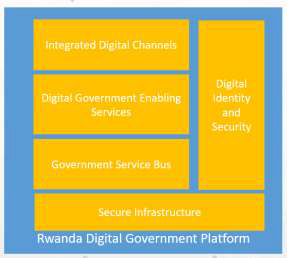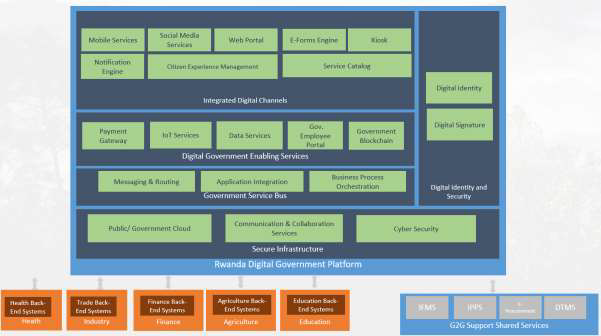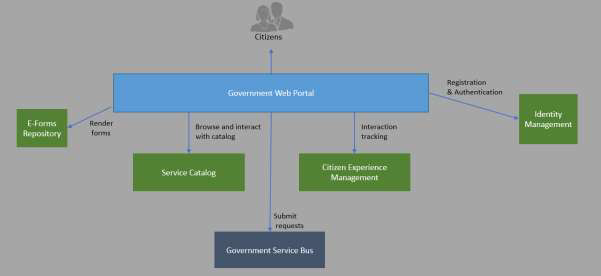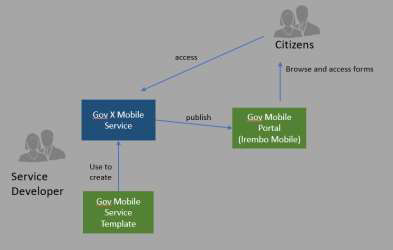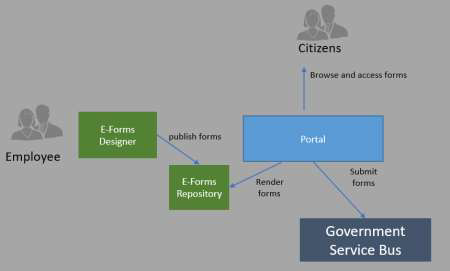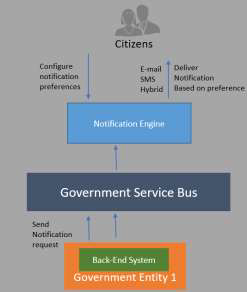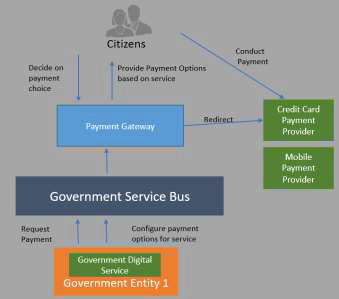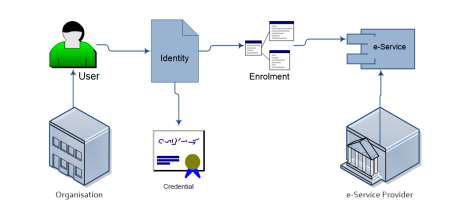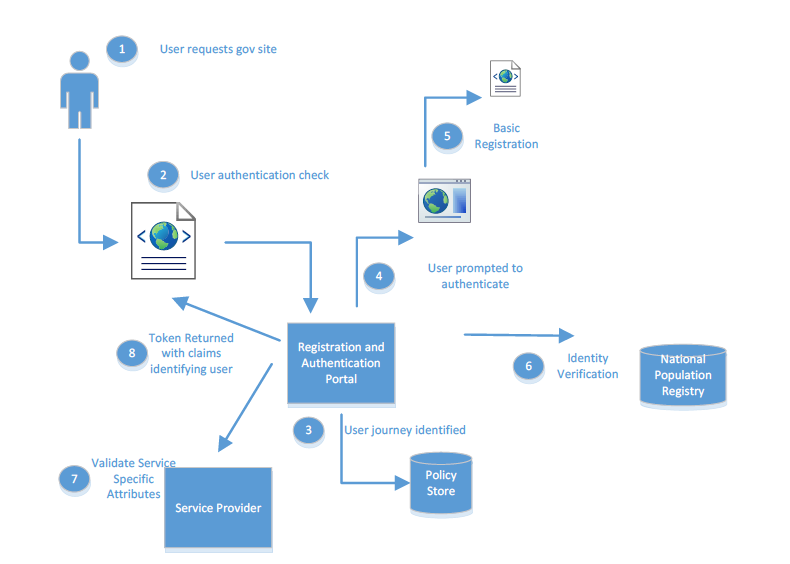Digital Government Platform Architecture
This section provides an overview of the proposed architecture for the Digital Government Platform.
Architecture Overview
The Digital Government Platform is not one single solution, but rather a set of technology components, architecture artefacts, and guidelines, that work together to facilitate all aspects related to building digital government services. The top-level components are listed below:
Integrated Digital Channels: Allows citizens to have a seamless interaction with the government, leveraging latest devices, social media, and other channels to provide unified citizen experiences.
Digital Government Enabling Services: Provide services such as payment, notification, and data management, to facilitate and accelerate the creation of digital services.
Digital Identity and Security: provides technology-based solutions for authenticating citizens and ensuring the security of transactions.
Government Service Bus: Accelerates the creation of new e-services through surfacing government data and processes, simplifying the creation of services that span multiple government entities.
Secure Infrastructure: Provides the backbone of systems, hardware, networking, and security that ensures a reliable, secure, and low-cost operation of government services.
These components are further broken down in the following diagram:
These components are described below.
Integrated Digital Channels
Overview
Integrated Digital Channels provide the possibility for seamless interaction of citizens with the government using multiple channels. Government services will be accessible from any location, through multiple types of devices, using a consistent user experience that is also contextaware.
Government Web Portal
The single point of access to government services on the web is the government web portal. “Irembo” is the current implementation of the Government Web Portal.
Using the portal, citizens and businesses can:
Get information on government and its services
Browse the catalog of services and get redirected to the proper location for accessing services (refer to the catalog services section)
Communicate directly with government entities
Transact with the government services directly using e-services
The web portal would provide some additional features that help in ensuring the best user
experience for users:
Integrate with Identity management to allow users to log in with chosen credentials and leverage single sign-on to access other services
Transaction History: Provide users with a history of the transactions that they have conducted with the government
Search: ability to search information available on the government portal as well as all government websites from a central place
Chatting/Chatbots: Provide ability to do online chatting with government service representatives, potentially leveraging automated artificial intelligence-enabled chatbots in appropriate scenarios.
The following diagrams show the interaction of the portal with other components:
While Irembo already provides a good entry point to a number of government services, some enhancements are recommended to be put in the roadmap for it to act as a gateway:
Integration with other government websites and services, including catalogs, yellow pages, search and sign-on capability across all government websites and other digital channels
Omni-Channel Access: The ability to start a transaction on one channel and continue it on another, such as beginning a birth certificate request on a phone app and then completing it and submitting it through Irembo.
Control of government entities over web form creation and maintenance, enabling the government entity owning the business to be able to manage the updates to the data and validation it requires from users. Refer to the e-Forms Engine section for details.
Mobile Services
More than 90% of Rwandans¹ access the Internet on their mobile devices. Therefore, it is natural that the interaction with the government should use mobile as the priority channel. Some government services are currently enabled on mobile using USSD. Irembo provides a responsive-design interface for rendering forms on small-screen devices, which helps significantly in making the e-services available on smartphones.
In addition to USSD apps and responsive web design, it is beneficial to create smartphone apps that provide a fluid and responsive mobile service to citizens. Creating one mobile app for government services would be desirable but is not feasible in practice, as it would provide significant challenges in terms of providing useful functionality that is easily accessible to citizens. Therefore, it is expected that multiple mobile apps would be created by the respective owners of services based on the needs.
In that context, centralized government mobile services would have the following objectives:
Enable standardized mobile-based access to services. Standardization would cover security, communication, branding, and look-and-feel, among others.
Ensure integration with other Digital Government Platform components, most notably, Identity Management and Single Sign-On on mobile devices, so that citizens can access mobile services using their assigned credentials.
Provide a central place (portal) for discovering and accessing mobile apps for government. The portal would be accessible through Irembo and as a mobile app used for launching other government apps.
Provide guidance, standards, and templates to government entities and third-party developers for building cross-platform mobile services. These would help ensure consistency even if the development of mobile app is created by multiple developers or vendors, as it is expected.
Social Media Services
Communicate frequently and announce on events and news:Social networks provide an opportunity to raise awareness about what’s happening with citizens
Openly listen and respond to citizen queries and feedback: Social networks contain a trove of information about citizens and government services. Addressing comments quickly can turn a good or bad citizen experience into long-term satisfaction. It also helps identify the things citizens care about. Social communities can also be a great source of highly detailed feedback and discussion from the people who use government services the most.
Analyze general sentiment and context-specific sentiment: Analyzing social streams allows the government to gather information, intelligence, and insights—leveraging connections with citizens and other organizations at local, national, and international levels.
Within the Digital Government Platform, Social Media Services provide the policies, procedures, and tools for a government agency to achieve the above objectives. It also integrates social media with other components, including the web portal, mobile services, and citizen experience management.
E-forms Engine
Automating government paper forms is a common requirement in accelerating the digitization of government business. At the moment, the Irembo team creates online forms for e-services, which requires an extensive programming effort, with the government entities having no control over form fields and validations. It is desirable to have a way to accelerate the form
creation and make it easy to publish and update government forms.
The e-Forms Engine complements the government web portal by providing a system for hosting e-form templates, a designer for templates creation and functionality that allows rendering e-forms in web browsers. The features from the e-Forms engine would be:
Simplify the creation of online forms following a standardized visual design
Simplify the submission of forms to web services for processing
Allow rendering of forms on multiple devices
Provide a centralized repository of forms
Two main components are there:
The e-forms Designer: supports easy creation of e-Form
It should be possible to create a form which will look like the paper version of
the form
No deep technical knowledge or programming required
Should support multiple languages
Allow entry validation
Allow complex logic and calculation
Ability to call web services during e-Form filling
The e-forms repository provides central repository of published e-Forms templates. Through web services it allows communication with e-Forms Designer and with the portal that is responsible for hosting e-Form Renderer and which is responsible for showing the list of templates.
Service Catalog
Hosted within the government web portal and mobile services, the Service Catalog provides a central place for citizens to learn about and navigate government services. It facilitates three main ways to browse services:
E-Services catalog: the catalog lists all services available to citizens, whether on the central government site or other government sites or channels. For each e-service, the catalog lists the service name, target users, benefits, fees, access mechanisms, government owner. The catalog also allows users to browse the services through different hierarchical categories.
Government Yellow Pages: hosted on the government web site, the government yellow pages allow citizens to navigate the structure of the government, including all departments and local offices, showing information about their web presence, contact information (phone, e-mail, etc.), and the services provided by these government entities.
Life Events: citizens and organizations interact with the government and access different services based on the lifecycle. After birth, citizens require birth registration, birth certificates, vaccination, and others. As he/she progresses in age, he/she will require education services, and others. Similarly, organizations pass through multiple
stages throughout their lifecycle. The Life Events feature allows citizens and organizations to access services organized per their lifecycle stages.
Moreover, by integrating with the Citizen Experience Management component, this module allows the government to be able to propose services to citizens proactively based on their own stage in the lifecycle, through integrating with notification services.
Kiosks
For citizens who are not able to access Internet-connected devices whether permanently or temporarily, the self-service Kiosk channel provides the opportunity for digital engagement with the government. Typically positioned in crowded public places, commonly accessed government offices, or in remote areas, the kiosks would be equipped with:
• Secure computer
• Touch-enabled screen
• A Web Camera
• Bio-metric authentication device
• Printer for receipts and others
• Connects the services with other channels
• Leverages touch screens for seamless experience
Kiosks should enable the customer experience to flow in an omni-channel way with the other channels such as web and mobile, in a way that allows starting one transaction in one of these channels and continuing on the kiosk, such as to print out a receipt.
Notification Engine
While delivering with services to citizens, the government sends multiple kinds of notifications in the lifecycle of service delivery, including e-mails, mobile text Messages, standard mail notifications, and others. It is important to standardize as well as consolidate and streamline messages sent to citizens, to ensure that messages are sent to citizens are consistent and result
in actionable outcome.
Currently the Irembo site delivers SMS and E-mail notification to users of its services, while other government entities have their own separate agreements with service providers to deliver SMS Messages.
The Notification Engine is a centralized component for streamlining citizen communication in relation with government services by:
Standardizing the format of messages
Customizing the delivery mechanism
Personalization of notification delivery
Centralization of messaging – such as citizens view all notifications in a single place
The Notification Engine will work as follows:
Citizens can configure, globally, their preferred notification mechanism (whether by SMS messages, e-mail, or others) and the corresponding contact addresses. They can also customize the type of notification based on service type and urgency. If the citizen changes his address or phone number or any contact mechanism, they only change it
from one place (through the government portal), and the new address is used for further notification.
When a government service wants to deliver a message to a citizen, it sends the message to the Notification Engine, specifying the target citizen, the Notification Engine will then deliver the message that is appropriate to the citizen’s preferences.
In the back-end, the entity responsible for Notification Engine will ensure the right contractual and technical mechanisms are put in place with vendors (such as SMS vendors) to leverage economies of scale for message transmission. The notification engine will also provide the feature of a Hybrid Inbox. This is an advanced notification mechanism that provides:
Centralized inbox containing all notifications for a citizen, accessed through web, mobile or other channels.
Digital signing of notifications to ensure authenticity and non-repudiation, through integration with the Digital Signature (PKI) infrastructure.
Certified proof of delivery, which can be leveraged for legally binding notifications.
Citizen Experience Management
As citizens get leverage multiple government services, on various channel, it is important toensure that all these interactions are managed in a coordinated way. The component ‘CitizenExperience Management’ acts as the unifying place for managing all citizen interactions andproviding a 360 degree view of the citizen. Borrowing from the concepts of “Customer
Relationship Management”, effectively treating citizens as customers, this component delivers
the following:
Records all citizen interactions across all channels, whether they are web or mobile
service requests, social media comments, or calls to the call center, and enables them
to be viewed per citizen.
It provides an update to date record on the status of all transactions that can be viewed
by the citizen directly on the available channels
Provides consolidate information, a single version of the truth, about citizens to
government employees, enabling them to provide exceptional service
Connect with data services, feeding information about citizen interactions and getting
insights around best actions for servicing the citizen.
Digital Government Enabling Services
Overview
This component provides services to facilitate and accelerate the creation of government digital services. They are used by the digital channels as well as by back-end systems to compete the back-end processing.
Payment Gateway
Most government transactions require some form of payment. In the digital government, payment for government services is expected to be made as simple and friction-free as possible. While the current government web site, Irembo, already has support for credit card payment through Visa and MasterCard, payment options need to be expanded further and
made usable across channels. The government payment gateway will have the following objectives:
Payment Gateway should support pluggable payment providers, allowing for flexible payment options that will change over time. These options would include:
Credit/debit/prepaid card payment
Mobile Payment
Payment with NFC
Payment through bank transfer
Payment through bank direct debit
Payment through third party payment providers that operate in Rwanda (such
as PayPal)
That payment gateway should publish standardized API-based integration to alloweasy onboarding of government service providers that require using online payment, as well as the integration of new payment providers.
In case the Government Gateway forms global agreements with payment providers onbehalf of the government, the Payment Gateway will provide settlement, dispute resolution and reconciliation services on behalf of the respective government entities that utilize the payment services.
That Payment Gateway would leverage the government PKI to ensure integrity and non-repudiation of transactions
The following diagram describes how the Payment Gateway is used in delivery of an online service:
Data Services
It is important for the government to make sense of available data in all aspects of delivery of information and services — from reducing operational costs to enhancing mission efficiency and delivering new and innovative citizen services — all the while preventing fraud/waste and abuses.
Data Services enables the government to leverage the vast amount of data it owns and collects to deliver the highest quality citizen services, leveraging data for insights and decisions. This has 3 components: Master Data Services, Big Data and Analytics, and Open Data Services, described below.
Master Data Services: Master Data is data that represents core business entities that enables consistent use across systems, of the most accurate, timely, and relevant version of truth. Examples are data about citizens, businesses, land registrations, etc. Related to Master Data are Reference Data, which are standardized terms, code values and other unique identifiers, business definitions for each value, business relationships within and across domain value lists. Examples are region codes, city codes, list of government hospitals, schools, etc. Master and Reference Data is used throughout government services, and the objectives of this component include:
Standardize codes used for all reference data
Ensure consolidation of duplicate records within and across data sources to
build and maintain global IDs to enable information integration.
Reconciliation across data sources and providing the ―golden record or the
best version of the truth.
Provision of access to the golden data across government applications, either
through direct reads (web services through the Government Service Bus), or by
replication feeds to databases
Big Data and Analytics: this component provides the tools and processes for storing, processing, and analyzing large amount of structured and un-structured data within the government. This allows monitoring and spotting trends that can help control costs, reduce waste, drive new efficiencies, and streamline overall operations. The objectives for Big Data would be:
Enable faster decision speed through greater access to insights
Manage government performance by linking collected data to government goals and Key Performance Indicators
Improve resource management by identifying areas of inefficiencies
Apply predictive analytics to uncover “unintended consequences”, unexpected patterns and associations and evaluate trends.
Open Data: Open Data for the government is a set of policies, process and tools that promotes transparency, accountability, and value creation by making government data available to all. This data can be used to attract nongovernmental sector and community, in general, for participation aiming at strong civic engagement.
The government produces large quantities of data and information, by making this data available, the private, social and government sectors are equipped with strong effective planning tool to institute new, value added, and innovative services for citizens, communities, and the society at large.
This component will provide the elements needed for exposing various types of data, weather structured or unstructured, allowing the ability to define the relevant sets of data catalogues, formats, and enables the rules for managing data publishers, subscribers, and data caching and delivery.
Government Employee Portal
The Government Employee Portal is used as a central place for employees to facilitate services to citizens, in addition to being an Intranet for information common to government workers.
The Government Employee Portal also includes the Task Management Service that allows employees to participate in long running government processes where no back-end system is present. It would work as follows:
As part of executing a Government Digital service, a service requires a task to be conducted by a government employee of an entity that has not automated its operations
The service would send a message to the Task Management Service to log a task for the employee, with the details of the task
The employee will log on to the Task Management service on the Employee Portal and views all his/her pending tasks
The employee will complete his task offline, and once done he/she will complete he will mark the task as complete in the portal
The service will be notified through a message that is sent over the Government Service Bus, and it will resume processing the service request.
Government Blockchain
Blockchain is a revolutionary technology that has started to gain grounds in government services after it has initially been used mainly in financial services. Blockchain provides a distributed ledger, that is secure, shared and immutable. In the government context, Blockchain technology promises greater integrity and transparency through fighting fraud and corruption, reduced cost of operations, and reduced costs of protecting citizens’ data while creating the possibility to share data between different entities. While the technology is still in its infancy, and as such presents risks associated with any new technology, it is beneficial to start experimenting with its applications.
Within the Digital Government Blueprint, the approach to blockchain is as follows:
Ensure that knowledge and expertise about the technology starts to develop within the government
Explore scenarios where the blockchain can be used to solve existing challenges. For example, the blockchain has been used in other African countries to facilitate distributed secure land registries. This could be one of the high priority scenarios for Rwanda as well.
Conduct Proof-of-Concepts to apply the usability of the technologies to the above scenarios. Again, the land registry scenario might be the one to start with.
Use the learnings from the Proof-of-Concepts to do detailed planning for rolling out the technology in production based on its feasibility assessment.
Digital Identity and Security
Overview
Providing Digital Identity that is secure and ubiquitous is one of the foundations of Digital Government. As described by the World Bank Digital Identity Toolkit:
“Digital Identity (eID) provides technology-based solutions for identification in order to uniquely establish a person’s identity and to credential it, so that the identity can be securely and unambiguously asserted and verified through electronic means for delivery of services across sectors, including healthcare, safety nets, financial services, and transport.”
The following definitions are important in addressing this section:
User: the individual to be identified, authenticated, and authorized to use certain services. It can be one of the following:
Individual: a citizen or non-citizen that will use the Gateway.
Employee of an Organization: a defined user that is linked to an organization for the purpose of using the e services
Agent Employee: a defined user that is linked to an Agency (defined below) for the purpose of using the e-services on behalf of other users
Identity: represents and identifies a user.
A user can choose to maintain several separate identities
Credential: information or other items that is verifiable to assert an identity. Multiple credentials may be associated with the same identity.
e-Service (or Service, or Digital Service): a logical grouping of business functionality offered by a service provider, with consistent rules governing authorization and access for users.
e-Service Provider: A Government Organization that provides online e-Services.
Enrolment: The linkage of an identity to a particular e-Service.
Agency: An organization that us authorized to use the e-Services on behalf of other users or organizations.
Digital Identity
This component provides technology-based solutions for identification in order to uniquely establish a person’s identity and to credential it. The identity has to be:
• Secure : allowing secure and authenticated access to services
• Multi-purpose: supporting multiple ways of authentication for multiple types of services and different security levels
• Mobile – ready : usable for accessing services through mobile channels The current status for Digital Identity in Rwanda can be summarized as follows:
• The National Population Registry maintained by NIDA forms the authoritative database for citizen identification
• The system also supports storing biometric information
• The citizen records can be tied to mobile phone numbers through collaborating with telco providers
• The government web site, Irembo, currently performs user registration by integrating with NIDA and the Telco providers
• Only user name / password is allowed as credential type in Irembo online services The Digital Identity component supports the following important features:
• Registration:
A user must register to access e-Services. The registration component ensures that a user’s credentials (e.g., user name and password, certificate) can be unquestionably tied to a real world identity.
Registration must be efficient, secure and require minimum human interaction
Registration for specific e-service should be allowed: once a user is registered for the Digital Government Platform, the e-service can specify that the user needs to extend his registration to access the e-service, which could include adding additional service-specific information
• Multiple Credentials
Multiple credential types should be supported, including:
Username/Password authentication
Digital Certificates (stored on Smart cards, Tokens, or other secure media)
Biometrics (fingerprints, iris scanning, facial recognition, or others)
Mobile ID (utilizing mobile SIM cards)
One Time Passwords (through SMS, Phone call verification, or others)
Other potential credential types in the future
Multiple security settings are associated with different e-services and as such corresponding credentials for each e-service should be based on its level of security. For example, a land registration transaction requires a higher level of security than filing a traffic complaint. In this example, the Service Provider for land registration would potentially require Digital Certificates, whereas complaint filing would accept username/password credentials.
A user can have multiple credentials and can choose to apply set of credentials based on:
Availability: whether it is possible to use the set of credential (e.g if he is carrying his smart card with him).
Channel: some credential types are not possible with mobile channels for example.
The security level for the service itself: different services might require different level of security assurance, as explained above.
Support for organizations identities and delegation
The service should allow identifying and registering organizations and their employees
Registration for businesses need to integrate with the central business registry
The procedure for adding employees shall be simple, in order to allow the easy expandability of e-services to the organizations.
The system should allow delegation for submitting service requests on behalf of other users for specific e-service requests (e.g: for laywers, other representatives)
- Support for Single Sign-On
- Single sign-on for Government Services allows citizens to be authenticated once on a certain channel (such as the web portal), and be able to access multiple services in the same session, even if these services are hosted on other locations or platforms. Without single sign on, citizens would have to remember multiple user names and passwords for multiple services, causing inconvenience as well as security issues in storing and managing passwords. Moreover, cases where services require going through forms across multiple government entities will not be possible to implement.
- While the vision may be to bring all online services on Irembo, this might not be feasible or practical, and as such the architecture should support multiple government services sites and should allow seamless navigation between them.
- Irembo currently provides a single credential to access many services. However:
- For the single sign-on to work, services currently need to be hosted on Irembo site.
- There is no provision for enabling access to other sites with the same credentials
- Other government sites require users to create and log in with different accounts : example is RISA, RRA
- Federated Identity is the enabler for single sign-on as it enables users from different trust domains to authenticate with their credentials in the home domain, but gain access to resources in other domains, based on established trust relationships between domains.
• The platform should support the following standards for enabling single sign-on
though identity federation:
- WS-Federation
- SAML 2.0
- OAuth 2.0
- OpenID Connect
• All channels need to integrate with Single Sign-On using the agreed upon federated
authentication protocol

